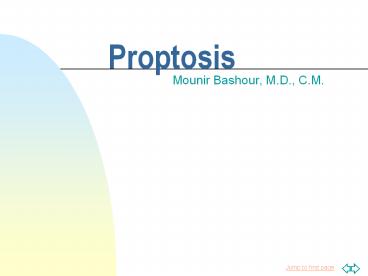Proptosis - PowerPoint PPT Presentation
Title:
Proptosis
Description:
Proptosis Mounir Bashour, M.D., C.M. What is proptosis? Forward protrusion of one or both eyeballs Unilateral asymmetric protrusion of one eye by at least 2 mm Normal ... – PowerPoint PPT presentation
Number of Views:2999
Avg rating:3.0/5.0
Title: Proptosis
1
Proptosis
- Mounir Bashour, M.D., C.M.
2
What is proptosis?
- Forward protrusion of one or both eyeballs
- Unilateral asymmetric protrusion of one eye by at
least 2 mm - Normal upper limits
- 22 mm in Caucasians
- 24 mm in African-Americans
3
How is proptosis diagnosed?
- Globes from above
- Measured with an exophthalmometer
- lateral orbital rim
- CT scan
4
List common problems associated with proptosis
- 1. Exposure keratopathy
- poor blink mechanism
- corneal abrasions and ulcers
- 2. Diplopia
- displacement of the globes
- extraocular muscle function
- 3. Optic nerve compression
- decreased visual acuity
- RAPD
- color vision deficit
- visual field defect
- prompt therapeutic intervention
5
Most common cause of unilateral proptosis?
- Thyroid eye disease (Graves' ophthalmopathy)
6
Most common cause of bilateral proptosis?
- Thyroid eye disease
7
What are other causes of proptosis?
- Orbital inflammatory pseudotumor
- Orbital infectious cellulitis
- Orbital tumors (benign or malignant)
- Lacrimal gland tumors
- Trauma (retrobulbar hemorrhage)
- Orbital vasculitis (i.e., polyartentts nodosa,
Wegener's granulomatosis) - Mucormycosis
- Carotid-cavernous fistula
- Orbital varix
8
List the causes of pseudoproptosis
- 1. Unilateral high axial myopia
- A-Scan
- 2. Actual enophthalmos of other eye
- 3. Upper lid retraction
9
Which neuroimaging test is best to evaluate the
etiology of proptosis?
- CT scans are superior in most cases
- MRI may be desirable in certain cases when optic
nerve dysfunction is present
10
Unilateral or bilateral painless proptosis,
eyelid retraction, eyelid lag, and motility
disturbances?
- Thyroid ophthalmopathy
- multisystem. autoimmune disorder
- hyperthyroid, hypothyroid, euthyroid
- inflammation and enlargement EOM
- IRgtMRgtSRgtLR
- fusiform enlargement sparing the tendon
- peribulbar tissues.
- Proptosis
- Eyelid retraction
- Corneal problems
- Diplopia
- Optic nerve compression
- Treatment depending on the severity
- Systemic and laboratory evaluation is mandatory
11
Unilateral proptosis, pain, conjunctival
injection, and motility disturbances in an adult?
- Orbital inflammatory pseudotumor
- nonspecific idiopathic inflammatory
- localized to muscle, lacrimal gland, sclera vs.
diffuse - eyelid erythema or edema
- palpable mass
- decreased vision
- uveitis
- hyperopic shift
- optic nerve edema
- Bilateral disease more common in children
- CT scan
- thickening 1 EOM (inc. tendons)
- lacrimal gland enlargement
- thickening of the posterior sclera
- Treatment corticosteroids /- radiation
12
Unilateral proptosis, pain, fever, decreased
ocular motility, erythema, and edema of the
eyelids?
- Infectious orbital cellulitis
- usually bacterial
- extended posterior to orbital septum
- meningitis
- cavernous sinus thrombosis
- staphylococci. streptococci. anaerobes, and
Haemophilus influenza (in children under 5 years
of age) - most common source -- ethmoid sinusitis
- intravenous antibiotics
13
Persistent proptosis or progression of infection
despite adequate antibiotic Rx
- Orbital subperiosteal abscess
- CT scan
- confirm diagnosis
- locate the abscess
- surgical drainage and continued intravenous
antibiotics
14
Child lt 6 y.o. with gradual, painless,
progressive, unilateral axial proptosis with
visual loss?
- Optic nerve glioma (juvenile pilocytic
astrocytoma) - slow-growing tumor
- Decreased visual acuity with a RAPD
- CT scan or MRI
- fusiform enlargement of the ON
- associated with NF1 Dx if bilateral
- Systemic evaluation and genetic counselling for
NF is essential
15
Child with rapidly progressive unilateral
proptosis, displacement of the globe inferiorly,
and edema of upper eyelid?
- Rhabdomyosarcoma
- most common primary orbital malignancy of
childhood - malignant growth of striated muscle tissue
- rapidly progressive mass in the superior orbit
with proptosis, globe displacement, and eyelid
swelling - average age of presentation is 7 years
- Prompt diagnosis with orbitotomy and biopsy is
crucial - overall mortality is 60 once the disease has
extended to orbital bones - Current Rx with radiation chemo have lowered
mortality rates to 5 to 10
16
Most common benign orbital tumor in adults that
causes unilateral proptosis?
- Cavernous hemangioma
- slow-growing vascular tumor
- usually diagnosed in young adulthood to middle
age - CT scan
- intraconal well-defined orbital mass
- Visual acuity is often not affected.
- Treatment observation or surgical excision
17
Most common malignant orbital tumor in adults
that causes unilateral proptosis?
- Orbital lymphomas
- typically superior orbit
- slow onset and progression
- subconjunctival salmon-colored" mass in the
fornix - CT scan
- poorly defined mass conforming to the shape of
the orbital bones and globe without bony erosion - orbital biopsy
- definitive treatment is radiation
- associated with systemic lymphoma therefore
medical consult and systemic evaluation are
necessary for all patients
18
Tumors that are encapsulated or appear well
circumscribed on neuroimaging
- Cavernous hemangioma
- Schwannoma
- Fibrohistiocytoma
- Neurofibroma
- Hemangiopericytoma































